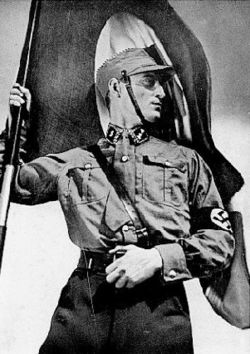Difference between revisions of "Sturmabteilung"
JohnJustice (Talk | contribs) (ce) |
JohnJustice (Talk | contribs) m |
||
| Line 1: | Line 1: | ||
[[Image:Sturmabteilungen.jpg|right|thumb|250px|An SA propaganda poster]] | [[Image:Sturmabteilungen.jpg|right|thumb|250px|An SA propaganda poster]] | ||
| − | The '''Sturmabteilung''' (German: "Assault Division"; abbreviated as '''SA'''), were a paramilitary organization within the [[Nazi Party]] in interwar [[Germany]], originally founded to protect Nazi meetings from disruption, and then used to intimidate, threaten, and commit acts of violence against political opponents as well as [[Jew]]s and other individuals opposed by party doctrines. Commonly referred to as "Brownshirts" due to the color of their uniforms or " | + | The '''Sturmabteilung''' (German: "Assault Division"; abbreviated as '''SA'''), were a paramilitary organization within the [[Nazi Party]] in interwar [[Germany]], originally founded to protect Nazi meetings from disruption, and then used to intimidate, threaten, and commit acts of violence against political opponents as well as [[Jew]]s and other individuals opposed by party doctrines. Commonly referred to as "Brownshirts" due to the color of their uniforms or "Storm troopers", the SA at its height numbered greater than twenty times that of the German Army. |
It was led by [[Ernst Röhm]], who had been a co-founder of the paramilitary organisation. During the early 1930s Röhm's SA ("brownshirts"), with 3 million members, was a much larger and more powerful part of the Nazi Party than [[Heinrich Himmler]]'s [[SS]]. That suddenly changed in June 1934 as a result of a power struggle between the SA, which had a more radical vision than Hitler would tolerate. A coalition of Himmler, [[Hermann Göring]], the army and big business found them to be unwieldy. The army feared the SA would absorb it into its ranks; which is what Röhm wanted to do. Himmler and [[Reinhard Heydrich]] prepared the list of Röhm's SA associates who were executed or imprisoned in the "[[Night of the Long Knives]]" which took place between June 30 and July 2, 1934.<ref>Kershaw, Ian. ''Hitler: A Biography'' (2008).</ref> Hitler had Röhm killed as well, for fear that he would be a rival in the near future.<ref>Lively, Scott & Abrams, Kevin. ''The Pink Swastika: Homosexuality in the Nazi Party'', 4th Edition.</ref> Himmler and his SS gained enormously from the killings; the SS became its own branch and Himmler reported only to Hitler.<ref>Weale, Adrian. ''The SS: A New History'' (2010).</ref> | It was led by [[Ernst Röhm]], who had been a co-founder of the paramilitary organisation. During the early 1930s Röhm's SA ("brownshirts"), with 3 million members, was a much larger and more powerful part of the Nazi Party than [[Heinrich Himmler]]'s [[SS]]. That suddenly changed in June 1934 as a result of a power struggle between the SA, which had a more radical vision than Hitler would tolerate. A coalition of Himmler, [[Hermann Göring]], the army and big business found them to be unwieldy. The army feared the SA would absorb it into its ranks; which is what Röhm wanted to do. Himmler and [[Reinhard Heydrich]] prepared the list of Röhm's SA associates who were executed or imprisoned in the "[[Night of the Long Knives]]" which took place between June 30 and July 2, 1934.<ref>Kershaw, Ian. ''Hitler: A Biography'' (2008).</ref> Hitler had Röhm killed as well, for fear that he would be a rival in the near future.<ref>Lively, Scott & Abrams, Kevin. ''The Pink Swastika: Homosexuality in the Nazi Party'', 4th Edition.</ref> Himmler and his SS gained enormously from the killings; the SS became its own branch and Himmler reported only to Hitler.<ref>Weale, Adrian. ''The SS: A New History'' (2010).</ref> | ||
Revision as of 02:53, March 10, 2014
The Sturmabteilung (German: "Assault Division"; abbreviated as SA), were a paramilitary organization within the Nazi Party in interwar Germany, originally founded to protect Nazi meetings from disruption, and then used to intimidate, threaten, and commit acts of violence against political opponents as well as Jews and other individuals opposed by party doctrines. Commonly referred to as "Brownshirts" due to the color of their uniforms or "Storm troopers", the SA at its height numbered greater than twenty times that of the German Army.
It was led by Ernst Röhm, who had been a co-founder of the paramilitary organisation. During the early 1930s Röhm's SA ("brownshirts"), with 3 million members, was a much larger and more powerful part of the Nazi Party than Heinrich Himmler's SS. That suddenly changed in June 1934 as a result of a power struggle between the SA, which had a more radical vision than Hitler would tolerate. A coalition of Himmler, Hermann Göring, the army and big business found them to be unwieldy. The army feared the SA would absorb it into its ranks; which is what Röhm wanted to do. Himmler and Reinhard Heydrich prepared the list of Röhm's SA associates who were executed or imprisoned in the "Night of the Long Knives" which took place between June 30 and July 2, 1934.[1] Hitler had Röhm killed as well, for fear that he would be a rival in the near future.[2] Himmler and his SS gained enormously from the killings; the SS became its own branch and Himmler reported only to Hitler.[3]
The term is sometimes erroneously broadened to include all Nazis and even all fascists, although strictly speaking Italian fascists were Blackshirts, for similar reasons of their uniform. [4] The term was also used in World War I to denote special trench assault units of the German Army.
Sources
- ↑ Kershaw, Ian. Hitler: A Biography (2008).
- ↑ Lively, Scott & Abrams, Kevin. The Pink Swastika: Homosexuality in the Nazi Party, 4th Edition.
- ↑ Weale, Adrian. The SS: A New History (2010).
- ↑ http://www.spartacus.schoolnet.co.uk/GERsa.htm
